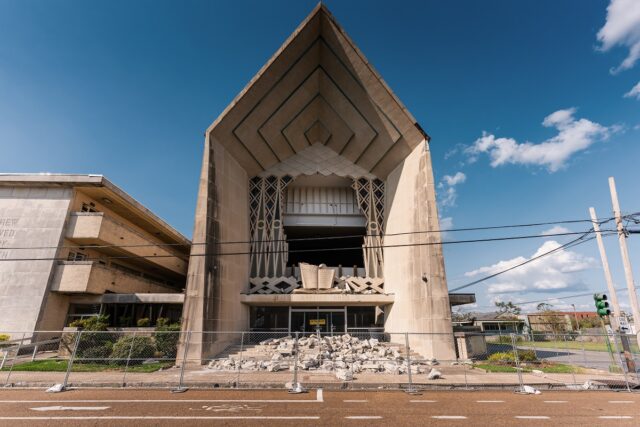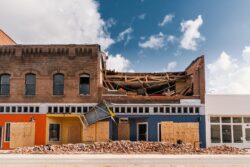A City Worth Saving
Confronting a changing Gulf Coast
Published: November 30, 2021
Last Updated: March 22, 2023

Photo by Chad Moreno
Panorama Music House, September 2020.
This is the last straw—not the category-five hurricane, not the hurricane that made landfall thirteen miles east just forty-three days later, not Winter Storm Uri that iced the city and left it without running water—this is the last straw that brings The Weather Channel to brand Lake Charles as “America’s most weather-battered city.” When I interviewed Mayor Nic Hunter in June 2021, he wondered aloud at the lack of a disaster aid bill, at the silence coming from Washington, DC: “Is Lake Charles not a city worth saving?”
But let’s get something straight: Lake Charles is not the whole of southwest Louisiana. Trouble is that when the nation fails to hear the cries of the region’s most recognized city, then the whole place is out of luck. If Lake Charles is not worth saving, then what must people think of Sweet Lake, Grand Chenier, Creole, Holly Beach?
With no savior in sight, I watch my homeland of southwest Louisiana morph into a place I no longer recognize. Something happens to a town that is continually stripped down to the studs, when what does remain rots, water-logged. As insurance adjusters walk around assessing what is salvageable—again—we look one another in the eye and ask: You leaving or you staying?
I gather that most people do not ask this existential question as often as we do. And perhaps in reference to a school or job, they may go their entire lives without asking it of the place they were born and raised. For us, lately, it’s a yearly, if not monthly, question.Tropical storm set to bring flooding rain, but not much wind. You staying or you leaving? This storm is a big one—the “unsurvivable” storm of our lifetime, the Hurricane Audrey of our generation. You leaving or you staying? Watch how someone phrases the question. What they suspect you might or should do is embedded in their way of asking.
In April 2021, the New York Times reported that more families were choosing to leave than stay. Lake Charles experienced the most net-out migration in the United States in 2020, a 6.7 percent increase from the previous year. That means thousands of families erased 7060-something as their zip code in 2020. The article mentions hurricanes in half a sentence, talking instead about the pandemic as a key factor.
Mayor Hunter set the record straight: this statistic is not about the pandemic. But neither is it shocking. These numbers signal transient migration. They are to be expected after a natural disaster, and they will be amended after folks repair their homes, hopefully.
But Mayor Hunter shared that sentiment before what he called the “the One-Thousand-Year Rain Event” flooded the city in May. By our June interview, he feared that the numbers were worse than what was reported. Disaster aid continues to be inaccessible for many families, some eighteen months after Laura. Schools are reopening for the year, but with thousands fewer students. He holds press conferences to compel President Biden, state representatives, and anyone who will listen to advocate for his city. Their silence is as eerie as the eye of a storm. He’s holding on to shreds of hope that folks have incentive, and means, to return.
When I query Representative Clay Higgins about why a federal disaster aid package did not come to southwest Louisiana in 2020, he assures me he is not to blame. The issue, as he sees it, aligns more with an April 2021 report from Robinson Meyer published in the Atlantic, which directs attention to lowering oil prices. In a personal interview with me in late June, Higgins talked for five straight minutes about oil and its effect on the region. Finally I broke in. “I want to know what these hurricanes are doing to the spirit of the people,” I said. Tears rolled down both of our faces. “My people can’t stand up,” he admitted. He confessed, too, that he could have pressed Washington harder; he could have acted more boldly, sooner.
The end of July, though, that’s when disaster aid was coming, Higgins promised. But disaster aid came later, at the beginning of October 2021, only after Hurricane Ida pummeled Houma, Port Fourchon, and towns on the other side of the state. Part of the problem was that FEMA was largely missing from the scene in southwest Louisiana. With the pandemic and virtual streaming as the norm, disaster relief teams observed the damage from a distance. As did the rest of the nation.
And from that vantage point—distant, late—it’s easy to dismiss the scene in southwest Louisiana as a tragedy. One long past. Experience it in the here and now, and you no longer bother with the business of leaving or staying. Instead, you simply wonder: Why would anyone stay?
I’m never doing this again.” This from the mouth of Felisha Nunez, my former school counselor, cheeks red, sweat dripping from her curly hair, upon her return to Cameron Parish after Hurricane Laura. And “this” refers to rebuilding a home that has been destroyed by a hurricane. She’s done it thrice before. Our exchange occurred as I handed Nunez a box of roofing nails for her and her husband to apply the band-aid that is the FEMA tarp.The Brister family determined that they were not returning to southwest Louisiana as they watched the coverage of Hurricane Laura blowing in from the safety of their hotel room. Micah, Melanie, and their two children returned to a home with minimal damage, but now they reside in southern Arkansas. It’s the only way they can think to find “mental recoup.” Because when they return to visit family, they realize that home no longer allows folks to exhale.
The Lannin family made the call to leave after discovering that they couldn’t tarp their home, as they had done with previous storms, because there was not enough roof on which to nail the tarp. Originally, they planned to move fifty miles north to Kinder, but Hurricane Delta drove them further. They felt certain that rebuilding their home, again, would result in one of them having a nervous breakdown. Six months into living in Eufaula, Oklahoma, however, there are still six boxes that Lisa refuses to unpack. And just a week ago, John looked at his surroundings and asked his wife, “Why didn’t you talk me out of this?”
So, it’s no surprise that most folks are not moving farther than Lafayette. Consider the Daigle family. They hoped to rebuild their home in Big Lake, but the insurance money they received was not enough to hire a contractor. “If it were just water,” Cheryl insists, they would know how to fix it. But they “didn’t know what to do with the busted windows and the molded ceilings.” They are now in Lafayette because that’s where their son is, where they could find an affordable apartment. And where it’s close enough to check housing on the regular should a place open up in Lake Charles.
Other families are moving only a town or two away, to Carlyss or Iowa. They don’t want to move too far because they still want to give their kids the same experiences growing up as they had—small town, small school, sports where everyone in the community shows up for the playoffs. Well, the same experience minus having their homes destroyed.
Jade Gotte, raising her kids less than a mile from Grand Lake School, the same school from which she graduated, decided to leave when she saw her four-year-old daughter pick her soaking Bible up from their front yard. She watched her daughter’s name bleed off the page and decided that she wanted different for her. Jade lost her childhood home in Cameron during Hurricane Rita, her next home in Creole during Hurricane Ike, and now her first home with her husband in Grand Lake. No more—she’s leaving.
It’s true that she’s not going far, that places like Iowa and Lafayette are not exactly out of the paths of hurricanes. No one has missed that fact. This is not about outrunning hurricanes. This is about moving far enough inland so that flooding and wind damage is a possibility, not a guarantee.
The refrain has echoed since last August: “I’m never doing this again.” But the promise seems hard to keep. I called my former school counselor a few days ago to check in. I found out that she’s doing it again.
I’ve been trying to tell you what it takes to leave southwest Louisiana. Admittedly, I haven’t been doing a very good job. Because, as it turns out, staying and leaving are two sides of the same coin. One inevitably leading to the other.Folks who stay close to home fantasize about leaving. The Nunez family, for example, hopes to leave Sweet Lake as soon as they can retire in three years. And the Brister family only keeps home close because, as it turns out, work as a tugboat captain is hard to find. So they reside in southern Arkansas, and Micah returns every other week to work his shifts out of the Port of Lake Charles.
Folks who leave, even folks like me who have been gone for nearly a decade, keep southwest Louisiana at an arm’s distance, visiting as often as we can, never ruling out a return, writing about it during sleepless nights to feel connected to the place, to the people. Or, like the Daigle and Lannin families, relentlessly plotting their return.
When you’re from southwest Louisiana, you’re always in that existential space of staying or leaving, no matter where you are. Sometimes leaving or staying is a matter of choice. More often, it’s a matter of the Gulf.
This is not about outrunning hurricanes. This is about moving far enough inland so that flooding and wind damage is a possibility, not a guarantee.
For the last three months, I’ve interviewed dozens of people who have made the decision to leave. Even in the wake of climate change, even in the wake of insurance abandonment, only one family is adamant that they will never return. Should these things continue happening—and all evidence suggests that it will—most of these folks don’t mind staying or leaving. That’s just part of home.
I get it. A few months after I left Grand Lake, my grandfather—born, raised, and now buried there—greeted me upon my first return home with a jar full of cattails from the marsh. He adorned the jar with a sign that read “Remember where you come from.” The jar now sits on my mantel some eight hundred miles away. I don’t even have to look at it to keep remembering.
I doubt it was intentional that he wrote “come from,” not “came from.” But I’ll always be glad that he did. The past tense would have been damning—a certain, definitive leaving. The present tense, by contrast, implies a continual state of emerging. I’m always in the process of coming from home, always becoming what the people in southwest Louisiana keep making me.
A notoriously difficult concept in quantum mechanics is something called “indeterminacy.” It’s the idea that, at the level of the particle, entities can occupy multiple locations simultaneously. Logically, it would seem that no one can occupy two places at once. But I think folks back home would understand it better than most: you staying or you leaving? It may as well be one and the same thing. Because southwest Louisiana is not a place you leave. It’s not a place you came from. It’s the place you come from.
Megan Poole was born and raised in Grand Lake, a small town south of Lake Charles, Louisiana. She is an assistant professor of English at the University of Louisville where she specializes in rhetoric.


